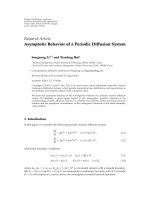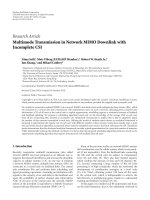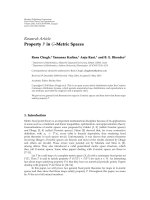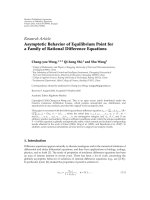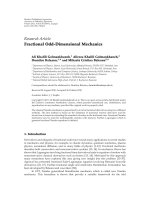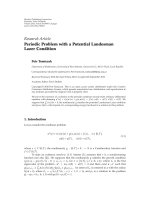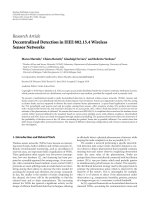báo cáo hóa học:" Research Article Asymptotic Constancy in Linear " pot
Bạn đang xem bản rút gọn của tài liệu. Xem và tải ngay bản đầy đủ của tài liệu tại đây (528.44 KB, 20 trang )
Hindawi Publishing Corporation
Advances in Difference Equations
Volume 2010, Article ID 789302, 20 pages
doi:10.1155/2010/789302
Research Article
Asymptotic Constancy in Linear Difference
Equations: Limit Formulae and Sharp Conditions
Istv
´
an Gy
˝
ori and L
´
aszl
´
o Horv
´
ath
Department of Mathematics, University of Pannonia, Egyetem u. 10. Veszpr
´
em 8200, Hungary
Correspondence should be addressed to Istv
´
an Gy
˝
ori,
Received 20 January 2010; Accepted 23 March 2010
Academic Editor: A
˘
gacik Zafer
Copyright q 2010 I. Gy
˝
ori and L. Horv
´
ath. This is an open access article distributed under the
Creative Commons Attribution License, which permits unrestricted use, distribution, and
reproduction in any medium, provided the original work is properly cited.
It is found that every solution of a system of linear delay difference equations has finite
limit at infinity, if some conditions are satisfied. These are much weaker than the k nown
sufficient conditions for asymptotic constancy of the solutions. When we impose some positivity
assumptions on the coefficient matrices, our conditions are also necessary. The novelty of our
results is illustrated by examples.
1. Introduction
Consider the nonautonomous linear delay difference system
y
n 1
− y
n
m
i1
A
i
n
y
n − τ
i
n
− y
n − σ
i
n
,n≥ 0, 1.1
where the following are considered.
A
1
m ≥ 1 is an integer, and A
i
n ∈ R
d×d
1 ≤ i ≤ m, n ≥ 0.
A
2
τ
i
n
n≥0
and σ
i
n
n≥0
are sequences of nonnegative integers 1 ≤ i ≤ m such
that
s : max
1≤i≤m
max
sup
n≥0
τ
i
n
, sup
n≥0
σ
i
n
1.2
is finite.
2 Advances in Difference Equations
Without loss of generality we may and do assume the following.
A
3
For each 1 ≤ i ≤ m and n ≥ 0,
τ
i
n
≤ σ
i
n
, 0 ≤ τ
1
n
≤···≤τ
m
n
. 1.3
Under these conditions, s max
1≤i≤m
{max
n≥0
σ
i
n}.
Whenever the delays are constants, we get the system
y
n 1
− y
n
m
i1
A
i
n
y
n − k
i
− y
n − l
i
,n≥ 0, 1.4
where we suppose that
A
4
k
i
<l
i
1 ≤ i ≤ m are nonnegative integers and
0 ≤ k
1
≤···≤k
m
. 1.5
In this case, s max
1≤i≤m
{l
1
, ,l
m
}.
Together with the above equations we assume initial conditions of the form
y
n
ψ
n
∈ R
d
, −s ≤ n ≤ 0, 1.6
where ψ :ψ−s, ,ψ−1,ψ0 ∈ R
s1d
. Clearly, 1.1 with 1.6and similarly 1.4
with 1.6 has a unique solution which exists for any n ≥ 0. The solution is denoted by
yψ :yψn
n≥−s
.
Driver et al. 1 have shown that if
m
i1
l
i
− k
i
A
i
n
≤ q<1,n≥ 0, 1.7
for some matrix norm ·on R
d×d
, then every solution yψ of 1.4 tends to a finite limit at
infinity which will be denoted by
y
ψ
∞
: lim
n →∞
y
ψ
n
. 1.8
In the paper of 2 the same statement has been proved under the condition
m
i1
jl
i
−1
njk
i
A
i
n
≤ q<1,j≥ 0. 1.9
Advances in Difference Equations 3
As we will show in Section 4.1 see Example 4.1, conditions 1.7 and 1.9 are independent
if the coefficients are time dependent. In the special case of 1.4 with constant coefficients
each A
i
n is independent of n
y
n 1
− y
n
m
i1
A
i
y
n − k
i
− y
n − l
i
,n≥ 0, 1.10
conditions 1.7 and 1.9 coincide and each reduces to
m
i1
l
i
− k
i
A
i
< 1. 1.11
Moreover, considering 1.10 under the condition A
4
, the existence of the finite limit
of each solution for whatever reason implies that
y
ψ
∞
I −
m
i1
l
i
− k
i
A
i
−1
⎛
⎝
ψ
0
−
m
i1
⎛
⎝
A
i
−k
i
−1
j−l
i
ψ
j
⎞
⎠
⎞
⎠
. 1.12
See 1.
In the nonautonomous case with constant delays, it has been proved by Pituk 2 that
the value of the limit can be characterized in an implicit formula by using a special solution
of the adjoint equation to 1.4 and the initial values.
In this paper we prove similar results for the general delay difference system
y
n 1
− y
n
n−1
jn−s
K
n, j
y
j 1
− y
j
,n≥ 0, 1.13
where
A
5
s ≥ 1 is an integer, and Kn, j ∈ R
d×d
n ≥ 0,n− s ≤ j ≤ n − 1.
The main novelty of our paper is that we prove the existence of the limit of the
solutions of the above equations under much weaker conditions than 1.9. Moreover,
utilizing our new limit formula, we show that some of our sufficient conditions are also
necessary.
After recalling some preliminary facts on matrices in the next section, we state
our main results on the asymptotic constancy of the solutions of 1.13, and derive a
generalization of the limit formula 1.12 to the time-dependent case Section 3. Section 4
is divided into three parts. In Section 4.1 we illustrate the independence of conditions 1.7
and 1.9. The relation between our new conditions is studied in Section 4.2.Inthethirdpart
of Section 4 we specialize to 1.1, 1.4,and1.10. The proofs of the main results are included
in Section 5.
4 Advances in Difference Equations
2. Preliminaries
If d ≥ 1 is an integer, the space of all d × d matrices is denoted by R
d×d
, the zero matrix by O,
and t he identity matrix by I. R
d×d
is a lattice under the canonical ordering defined by what
follows: A ≤ B means that a
ij
≤ b
ij
for every 1 ≤ i, j ≤ d, where A a
ij
and B b
ij
.Of
course, the absolute value of A a
ij
∈ R
d×d
is given by |A| |a
ij
|. The spectral radius of
a matrix A ∈ R
d×d
is denoted by ρA. It is well known that for any norm ·on R
d×d
we
have ρAlim
n →∞
A
n
1/n
≤A.WeusethatA, B, C ∈ R
d×d
, A ≤ B,andC ≥ O imply that
AC ≤ BC.
3. The Main Results
Consider the general delay difference system 1.13 with the initial condition 1.6. This initial
value problem has a unique solution which is denoted by yψ :yψn
n≥0
.
In our first theorem we give a new limit formula in terms of the initial values. To this
end, we introduce the linear mapping c : R
s1d
→ R
d
which is defined by
c
ψ
: ψ
0
0
j−s1
j−1
l−s
K
j − l − 1,j − 1
− K
j − l, j
ψ
j
−
−1
l−s
K
0,l
ψ
l
3.1
for any ψ :ψ−s, ,ψ−1,ψ0 ∈ R
s1d
.
Theorem 3.1. Assume A
5
. For an initial sequence ψ ∈ R
s1d
, t he solution yψ of 1.13 and
1.6 has a finite limit if and only if
d
ψ
: lim
n →∞
−1
l−s
K
n, n l
y
ψ
n l 1
n−s−1
j1
−1
l−s
K
j − l − 1,j − 1
− K
j − l, j
y
ψ
j
n−1
jn−s
⎛
⎝
−1
lj−n
K
j − l − 1,j − 1
− K
j − l, j
⎞
⎠
y
ψ
j
⎞
⎠
3.2
is finite, and in this case
y
ψ
∞
: lim
n →∞
y
ψ
n
c
ψ
d
ψ
. 3.3
In the next theorem we prove the convergence of the solutions of 1.13 under a
condition much weaker than 1.9, as it is illustrated in Section 4.3.
Advances in Difference Equations 5
Theorem 3.2. Assume A
5
.If
either
lim sup
j →∞
js
nj1
K
n, j
< 1, 3.4
for some matrix norm ·on R
d×d
,or
B : lim sup
j →∞
js
nj1
K
n, j
3.5
is finite with ρB < 1, then for every initial sequence ψ ∈ R
s1d
the solution yψ of
1.13 and 1.6 has a finite limit which obeys 3.3.
For the independence of conditions 3.4 and 3.5,seeSection 4.1.
As a corollary, we get the next result.
Corollary 3.3. Assume A
5
, and for each l ∈{1, ,s} let the limit
L
l
: lim
n →∞
K
n l, n
3.6
be finite. Then the following are considered.
a If for an initial sequence ψ ∈ R
s1d
the solution yψ of 1.13 and 1.6 has a finite limit,
then
I −
s
l1
L
l
y
ψ
∞
c
ψ
∞
j1
−1
l−s
K
j − l − 1,j − 1
− K
j − l, j
y
ψ
j
. 3.7
b If either
s
l1
L
l
< 1, 3.8
for some matrix norm ·on R
d×d
,or
ρ
s
l1
|
L
l
|
< 1, 3.9
6 Advances in Difference Equations
then for every initial sequence ψ ∈ R
s1d
the solution yψ of 1.13 and 1.6 has a finite
limit which obeys
y
ψ
∞
I −
s
l1
Ll
−1
⎛
⎝
c
ψ
∞
j1
−1
l−s
K
j − l − 1,j − 1
− K
j − l, j
y
ψ
j
⎞
⎠
.
3.10
Now consider the equation
y
n 1
− y
n
n−1
jn−s
L
n − j
y
j 1
− y
j
,n≥ 0, 3.11
where Ll ∈ R
d×d
for each l ∈{1, ,s}.
Based on the above results we give a necessary and sufficient condition for the
solutions of 3.11 to have a finite limit.
Theorem 3.4. Consider 3.11.
a If for every initial sequence ψ ∈ R
s1d
the solution yψ of 3.11 and 1.6 has a finite
limit, then
y
ψ
∞
I −
s
l1
Ll
−1
ψ
0
−
−1
l−s
L
−l
ψ
l
. 3.12
b Assume that Ll ≥ O for each l ∈{1, ,s}. Then the next two statements are equivalent.
i For every initial sequence ψ ∈ R
s1d
the solution yψ of 3.11 and 1.6 has a
finite limit.
ii And
ρ
s
l1
L
l
< 1. 3.13
4. Discussion and Applications
4.1. Comparison of Conditions 1.7 and 1.9
The independence of conditions 1.7 and 1.9 is illustrated by the next example.
Example 4.1. Let m 2, k
1
k
2
0, l
1
1, and l
2
2. Elementary considerations show the
following.
Advances in Difference Equations 7
a If
A
1
n
⎧
⎪
⎨
⎪
⎩
1
2
, if n ≥ 0 is even,
0, if n ≥ 0 is odd,
A
2
n
⎧
⎪
⎪
⎨
⎪
⎪
⎩
5
24
, if n ≥ 0 is even,
1
3
, if n ≥ 0 is odd,
4.1
then condition 1.7 is satisfied, but condition 1.9 does not hold.
b If
A
1
n
⎧
⎪
⎪
⎨
⎪
⎪
⎩
1
2
, if n ≥ 0 is even,
1
4
, if n ≥ 0 is odd,
A
2
n
⎧
⎪
⎨
⎪
⎩
9
20
, if n ≥ 0 is even,
0, if n ≥ 0 is odd,
4.2
then condition 1.7 does not hold, but condition 1.9 is satisfied.
4.2. Independence of Conditions 3.4 and 3.5
It is illustrated by the following two examples that condition 3.4 does not generally imply
condition 3.5 and conversely.
Example 4.2. Let the matrices Kn, n − 1 and Kn, n − 2n ≥ 0 be defined by
K
n, n − 1
:
⎛
⎜
⎜
⎝
4n 5
5
n 1
0
0
1
n 1
⎞
⎟
⎟
⎠
,K
n, n − 2
:
⎛
⎜
⎜
⎜
⎝
1
n 1
0
0
2n 3
5
n 1
⎞
⎟
⎟
⎟
⎠
. 4.3
Since
ρ
K
n, n − 1
4n 5
5
n 1
≥
4
5
,ρ
K
n, n − 2
2n 3
5
n 1
≥
2
5
,n≥ 1, 4.4
yield that
K
n, n − 1
≥
4
5
,
K
n, n − 2
≥
2
5
,n≥ 1, 4.5
for every matrix norm ·on R
2×2
, hence
lim
j →∞
j2
nj1
K
n, j
≥
6
5
> 1 4.6
for every matrix norm on R
2×2
.
8 Advances in Difference Equations
On the other hand
ρ
⎛
⎝
lim
j →∞
j2
nj1
K
n, j
⎞
⎠
ρ
⎛
⎜
⎝
⎛
⎜
⎝
4
5
0
0
2
5
⎞
⎟
⎠
⎞
⎟
⎠
4
5
< 1. 4.7
We can see that there are situations in which 3.5 is satisfied but 3.4 is not.
Example 4.3. Let the matrices Kn, n − 1 and Kn, n − 2n ≥ 0 be defined by
K
n, n − 1
:
⎛
⎜
⎜
⎜
⎝
3n
10n 1
3n
10n 1
−
3n
10n 1
3n
10n 1
⎞
⎟
⎟
⎟
⎠
,K
n, n − 2
:
⎛
⎜
⎜
⎜
⎝
3
10
3
10
−
3
10
3
10
⎞
⎟
⎟
⎟
⎠
. 4.8
Observe that
ρ
⎛
⎜
⎜
⎜
⎝
⎛
⎜
⎜
⎜
⎝
3
10
3
10
−
3
10
3
10
⎞
⎟
⎟
⎟
⎠
⎞
⎟
⎟
⎟
⎠
3 · 2
1/2
10
<
9
20
, 4.9
and therefore there exists a matrix norm ·on R
2×2
such that
⎛
⎜
⎜
⎜
⎝
3
10
3
10
−
3
10
3
10
⎞
⎟
⎟
⎟
⎠
<
9
20
. 4.10
From
lim
n →∞
K
n, n − 1
⎛
⎜
⎜
⎜
⎝
3
10
3
10
−
3
10
3
10
⎞
⎟
⎟
⎟
⎠
4.11
and from 4.10, it follows that there is an integer n
0
≥ 0 such that
K
n, n − 1
<
9
20
,n≥ n
0
. 4.12
This together with 4.10 gives that
lim
j →∞
j2
nj1
K
n, j
<
9
10
< 1. 4.13
Advances in Difference Equations 9
Finally,
ρ
⎛
⎝
lim
j →∞
j2
nj1
K
n, j
⎞
⎠
ρ
⎛
⎜
⎜
⎜
⎝
⎛
⎜
⎜
⎜
⎝
3
5
3
5
3
5
3
5
⎞
⎟
⎟
⎟
⎠
⎞
⎟
⎟
⎟
⎠
6
5
> 1. 4.14
We can see that 3.4 does not imply 3.5 in general.
Suppose that Kn, j ≥ O n ≥ 0,n− s ≤ j ≤ n − 1 and the limit
lim
n →∞
K
n l, n
4.15
is finite for each l ∈{1, ,s}. In this case condition 3.4 guarantees that condition 3.5 also
holds. Really,
1 > lim
j →∞
js
nj1
K
n, j
s
l1
lim
j →∞
K
j l, j
s
l1
lim
j →∞
K
j l, j
≥
s
l1
lim
j →∞
K
j l, j
lim
j →∞
js
nj1
K
n, j
≥ ρ
⎛
⎝
lim
j →∞
js
nj1
K
n, j
⎞
⎠
.
4.16
However, the implication discussed above may be lost if 4.15 is not satisfied, even if
the matrices Kn, j are nonnegative, as the following example shows.
Example 4.4. Let the matrix Kn, n − 1n ≥ 0 be defined by
K
n, n − 1
:
⎛
⎜
⎝
2
3
0
0
2
3
⎞
⎟
⎠
, if n is even,
K
n, n − 1
:
⎛
⎜
⎝
0
2
3
2
3
0
⎞
⎟
⎠
, if n is odd.
4.17
Using the l
1
-norm ·
1
on R
2×2
, we have
lim sup
j →∞
Kj 1,j
1
2
3
< 1, 4.18
10 Advances in Difference Equations
while
ρ
lim sup
j →∞
K
j 1,j
ρ
⎛
⎜
⎜
⎜
⎝
⎛
⎜
⎜
⎜
⎝
2
3
2
3
2
3
2
3
⎞
⎟
⎟
⎟
⎠
⎞
⎟
⎟
⎟
⎠
4
3
> 1. 4.19
4.3. Application to Delay Difference Equations
For every 1 ≤ i ≤ m and n ≥ 0 let the function χ
i
n, · be defined on the set of integers by
χ
i
n, j
:
⎧
⎨
⎩
1,n− σ
i
n
≤ j ≤ n − τ
i
n
− 1,
0, otherwise.
4.20
Lemma 4.5. Assume A
1
–A
3
. Then the delay difference 1.1 is equivalent to 1.13 if for every
n ≥ 0 Kn, · is defined by
K
n, j
:
m
i1
χ
i
n, j
A
i
n
,n− s ≤ j ≤ n − 1. 4.21
Proof. It is easy to see that
y
n − τ
i
n
− y
n − σ
i
n
n−τ
i
n−1
jn−σ
i
n
y
j 1
− y
j
,n≥ 0. 4.22
By using 4.20 we get
y
n − τ
i
n
− y
n − σ
i
n
n−1
jn−s
χ
i
n, j
y
j 1
− y
j
,n≥ 0. 4.23
Thus 1.1 can be written in the form
y
n 1
− y
n
m
i1
⎛
⎝
A
i
n
n−1
jn−s
χ
i
n, j
y
j 1
− y
j
⎞
⎠
n−1
jn−s
m
i1
χ
i
n, j
A
i
n
y
j 1
− y
j
,n≥ 0.
4.24
The proof is complete.
The following result is an immediate consequence of Theorem 3.2 and Lemma 4.5,and
it gives sufficient conditions for the convergence of the solutions of 1.1.
Advances in Difference Equations 11
Theorem 4.6. Assume A
1
–A
3
.Ifeither
lim sup
j →∞
js
nj1
m
i1
χ
i
n, j
A
i
n
< 1, 4.25
for some matrix norm ·on R
d×d
,or
B : lim sup
j →∞
js
nj1
m
i1
χ
i
n, j
A
i
n
4.26
is finite with ρB < 1, then for every initial sequence ψ ∈ R
s1d
the solution yψ of
1.1 and 1.6 has a finite limit which obeys 3.3.
Now consider the constant delay equation 1.4. For every 1 ≤ i ≤ m, let the function
χ
c
i
be defined on the set of integers by
χ
c
i
l
:
⎧
⎨
⎩
1,k
i
1 ≤ l ≤ l
i
,
0, otherwise.
4.27
In 1.4 τ
i
nk
i
and σ
i
nl
i
for every 1 ≤ i ≤ m and n ≥ 0; thus the function χ
i
n, ·
defined in 4.20 satisfies
χ
i
n, j
χ
c
i
n − j
, 1 ≤ i ≤ m, n ≥ 0, 4.28
for each integer j. So, in the constant delay case, from Theorem 4.6 we get the next result.
Theorem 4.7. Assume A
1
and A
4
.Ifeither
lim sup
j →∞
js
nj1
m
i1
χ
c
i
n − j
A
i
n
< 1, 4.29
for some matrix norm ·on R
d×d
,or
B : lim sup
j →∞
js
nj1
m
i1
χ
c
i
n − j
A
i
n
4.30
is finite with ρB < 1, then for every initial sequence ψ ∈ R
s1d
the solution yψ of
1.4 and 1.6 has a finite limit which obeys 3.3.
12 Advances in Difference Equations
Remark 4.8. Our condition 4.29 is weaker than condition 1.9. In fact
js
nj1
m
i1
χ
c
i
n − j
A
i
n
≤
js
nj1
m
i1
χ
c
i
n − j
A
i
n
m
i1
⎛
⎝
js
nj1
χ
c
i
n − j
A
i
n
⎞
⎠
m
i1
⎛
⎝
jl
i
njk
i
1
A
i
n
⎞
⎠
,j≥−s.
4.31
Therefore
lim sup
j →∞
js
nj1
m
i1
χ
c
i
n − j
A
i
n
≤ lim sup
j →∞
m
i1
⎛
⎝
jl
i
njk
i
1
A
i
n
⎞
⎠
lim sup
j →∞
m
i1
⎛
⎝
jl
i
−1
njk
i
A
i
n
⎞
⎠
< 1,
4.32
assuming that 1.9 holds.
In the next example our condition 4.29 holds, but neither condition 1.9 nor
condition 1.7 can be applied.
Example 4.9. Consider
y
n 1
− y
n
n 1
4n
y
n
− y
n − 2
−
n 1
3n
y
n − 1
− y
n − 3
,n≥ 0. 4.33
An elementary calculation shows that
j3
nj1
2
i1
χ
i
n, j
A
i
n
j 2
4
j 1
j 3
4
j 2
−
j 3
3
j 2
j 4
3
j 3
−→
2
3
< 1, 4.34
while
2
i1
l
i
− k
i
|
A
i
n
|
2
n 1
4n
2
n 1
3n
−→
7
6
> 1,
2
i1
⎛
⎝
jl
i
njk
i
1
|
A
i
n
|
⎞
⎠
j 2
4
j 1
j 3
4
j 2
j 3
3
j 2
j 4
3
j 3
−→
7
6
> 1.
4.35
Advances in Difference Equations 13
By applying Theorem 4.7 and Theorem 3.4b,wegivesufficient and also necessary
conditions for the solutions of 1.4 to be asymptotically constant, if in addition each matrix
A
i
n is constant independent of n.
Theorem 4.10. Assume A
1
and A
4
with A
i
nA
i
for each 1 ≤ i ≤ m and n ≥ 0. Then the
following are considered.
a If either
s
l1
m
i1
χ
c
i
l
A
i
< 1, 4.36
for some matrix norm ·on R
d×d
,or
ρ
s
l1
m
i1
χ
c
i
l
A
i
< 1, 4.37
then for every initial sequence ψ ∈ R
s1d
the solution yψ of 1.10 and 1.6 has a finite
limit.
b Assume that
m
i1
χ
c
i
l
A
i
≥ O 4.38
for each l ∈{1, ,s}. Then the next two statements are equivalent.
i For every initial sequence ψ ∈ R
s1d
the solution yψ of 1.10 and 1.6 has a
finite limit.
ii And
ρ
s
l1
m
i1
χ
c
i
l
A
i
< 1. 4.39
Remark 4.11. Condition 4.38 does not require the positivity of the coefficient matrices
A
i
i 1, ,m. To illustrate this, see the following example. To the best of our knowledge,
no similar result has been proved for 1.10 with both positive and negative coefficients.
14 Advances in Difference Equations
Example 4.12. Consider the scalar difference equation
y
n 1
− y
n
A
1
y
n
− y
n − 1
A
2
y
n
− y
n − 2
,n≥ 0, 4.40
which is a special case of 1.10. Then
χ
c
1
1
A
1
χ
c
2
1
A
2
A
1
A
2
,χ
c
1
2
A
1
χ
c
2
2
A
2
A
2
. 4.41
Consequently, the conditions in 4.38 have the form
A
1
A
2
≥ 0,A
2
≥ 0, 4.42
showing clearly that A
1
may be negative.
Remark 4.13. Of course, we have from Theorem 3.4ausing that Ll
m
i1
χ
c
i
lA
i
, l
1, ,s) that if for every initial sequence ψ ∈ R
s1d
the solution yψ of 1.10 and 1.6 has
a finite limit, then 1.12 holds.
5. Proofs of the Main Results
Proof of Theorem 3.1. Since
y
ψ
n 1
ψ
0
n
i0
y
ψ
i 1
− y
ψ
i
,n≥ 0, 5.1
it comes from 1.13 that
y
ψ
n 1
ψ
0
n
i0
⎛
⎝
i−1
ji−s
K
i, j
y
ψ
j 1
− y
ψ
j
⎞
⎠
ψ
0
n
i0
−1
l−s
K
i, i l
y
ψ
i l 1
− y
ψ
i l
ψ
0
−1
l−s
n
i0
K
i, i l
y
ψ
i l 1
− y
ψ
i l
,n≥ 0.
5.2
Advances in Difference Equations 15
Now a simple calculation confirms that
y
ψ
n 1
ψ
0
−1
l−s
⎛
⎝
nl1
jl1
K
j − l − 1,j − 1
y
ψ
j
−
nl
jl
K
j − l, j
y
ψ
j
⎞
⎠
ψ
0
−1
l−s
K
n, n l
y
ψ
n l 1
−
−1
l−s
K
0,l
y
ψ
l
−1
l−s
⎛
⎝
nl
jl1
K
j − l − 1,j − 1
− K
j − l, j
y
ψ
j
⎞
⎠
ψ
0
−
−1
l−s
K
0,l
ψ
l
−1
l−s
K
n, n l
y
ψ
n l 1
0
j−s1
j−1
l−s
K
j − l − 1,j − 1
− K
j − l, j
ψ
j
n−s−1
j1
−1
l−s
K
j − l − 1,j − 1
− K
j − l, j
y
ψ
j
n−1
jn−s
⎛
⎝
−1
lj−n
K
j − l − 1,j − 1
− K
j − l, j
⎞
⎠
y
ψ
j
c
ψ
−1
l−s
K
n, n l
y
ψ
n l 1
n−s−1
j1
−1
l−s
K
j − l − 1,j − 1
− K
j − l, j
y
ψ
j
n−1
jn−s
⎛
⎝
−1
lj−n
K
j − l − 1,j − 1
− K
j − l, j
⎞
⎠
y
ψ
j
,n≥ s 2.
5.3
From 5.3 the assertion and the desired relation 3.3 follow, bringing the proof to an end.
In order to prove Theorem 3.2, we need the following Lemma from 3, Corollary
10b.
Lemma 5.1. Consider the initial value problem
x
n
n−1
jn−s
B
n, j
x
j
,n≥ 0,
x
n
ϕ
n
, −s ≤ n ≤−1,
5.4
16 Advances in Difference Equations
where s ≥ 1 is a given integer, Bn, j ∈ R
d×d
n ≥ 0,n−s ≤ j ≤ n−1, and ϕn ∈ R
d
−s ≤ n ≤−1.
The unique solution of 5.4 is denoted by xϕ.Let·
d
be a norm on R
d
.If
lim sup
j →∞
js
nj1
B
n, j
< 1 5.5
is satisfied for some matrix norm ·on R
d×d
, then there are numbers c : c·
d
,ϕ ≥ 0 and
0 <q<1 such that
xϕn
d
≤ cq
n
,n≥ 0. 5.6
Proof of Theorem 3.2. Fix an initial value ψ :ψ−s, ,ψ−1,ψ0 ∈ R
s1d
.
Since
y
ψ
N 1
ψ
0
N
n0
y
ψ
n 1
− y
ψ
n
,N≥ 0, 5.7
it is enough to show that the series
∞
n0
y
ψ
n 1
− y
ψ
n
5.8
is convergent.
Suppose 3.4.Let·
d
be a norm on R
d
. According to Lemma 5.1,
∞
n0
yψn 1 − yψn
d
< ∞, 5.9
so the series 5.8 is convergent.
Now suppose 3.5. Obviously, the convergence of the series 5.8 comes from the
convergence of the series
∞
n0
y
ψ
n 1
− y
ψ
n
. 5.10
Moreover, the members of the previous series are nonnegative, so it suffices to prove that the
sequence
N
n0
yψn 1 − yψn
N≥0
5.11
is bounded.
Advances in Difference Equations 17
Let E e
ij
be the matrix in R
d×d
, where e
ij
: 1 for each pair i, j. By the definition
of the matrix B, for each positive number ε there exists a nonnegative integer jε such that
js
nj1
K
n, j
≤ B εE, j ≥ j
ε
. 5.12
The property ρB < 1 insures that we can choose a positive number ε
0
such that ρB ε
0
E <
1. We set
C : B ε
0
E, j
0
: j
ε
0
. 5.13
Equation 1.13 implies that
N
n0
y
ψ
n 1
− y
ψ
n
≤
N
n0
⎛
⎝
n−1
jn−s
K
n, j
y
ψ
j 1
− y
ψ
j
⎞
⎠
≤
−1
j−s
js
n0
K
n, j
ψ
j 1
− ψ
j
N
j0
⎛
⎝
js
nj1
K
n, j
⎞
⎠
y
ψ
j 1
− y
ψ
j
−1
j−s
js
n0
K
n, j
ψ
j 1
− ψ
j
j
0
j0
⎛
⎝
js
nj1
K
n, j
⎞
⎠
y
ψ
j 1
− y
ψ
j
N
jj
0
1
⎛
⎝
js
nj1
K
n, j
⎞
⎠
×
y
ψ
j 1
− y
ψ
j
,N≥ j
0
1 s.
5.14
Introducing the notation
b
ψ
:
−1
j−s
js
n0
K
n, j
ψ
j 1
− ψ
j
j
0
j0
⎛
⎝
js
nj1
K
n, j
⎞
⎠
y
ψ
j 1
− y
ψ
j
,
5.15
18 Advances in Difference Equations
and using 5.12 and 5.13, we calculate
N
n0
y
ψ
n 1
− y
ψ
n
≤ b
ψ
C
N
jj
0
1
y
ψ
j 1
− y
ψ
j
≤ b
ψ
C
N
j0
y
ψ
j 1
− y
ψ
j
,N≥ j
0
1 s.
5.16
Hence
I − C
N
n0
y
ψ
n 1
− y
ψ
n
≤ b
ψ
,N≥ j
0
1 s. 5.17
Because the matrix C was chosen to satisfy ρC < 1andC is nonnegative, I −C is invertible
and I − C
−1
is nonnegative too. Therefore, 5.16 yields that
N
n0
y
ψ
n 1
− y
ψ
n
≤
I − C
−1
b
ψ
,N≥ j
0
1 s, 5.18
and this gives the boundedness of the sequence 5.11.
The proof is complete.
Proof of Corollary 3.3. a By 3.6,
lim
n →∞
−1
l−s
K
n, n l
y
ψ
n l 1
−1
l−s
L
l
y
ψ
∞
. 5.19
From 3.6 it also follows that
lim
n →∞
n−1
jn−s
⎛
⎝
−1
lj−n
K
j − l − 1,j − 1
− K
j − l, j
⎞
⎠
y
ψ
j
lim
n →∞
−1
k−s
−1
lk
K
n k − l − 1,n k − 1
− K
n k − l, n k
× y
ψ
n k
0.
5.20
Equations 5.19 and 5.20 together with Theorem 3.1 give the result.
b Since conditions 3.8 and 3.9 imply that the matrix
I −
s
l1
L
l
5.21
is invertible, we can apply Theorem 3.2 and 3.7.
Advances in Difference Equations 19
Proof of Theorem 3.4. a Equations 3.7 in Corollary 3.3 and 3.1 imply that
I −
s
l1
L
l
y
ψ
∞
ψ
0
−
−1
l−s
L
−l
ψ
l
. 5.22
Our goal is to prove that the matrix
I −
s
l1
L
l
5.23
is invertible. To this end, we choose initial sequences ψ ψ−s, ,ψ−1,ψ0 of the form
ψ−s··· ψ−10. Then 5.22 shows that the linear mapping
x −→
I −
s
l1
L
l
x, x ∈ R
d
5.24
is surjective, whence it is an isomorphism. Consequently, 5.23 is invertible. Now the result
follows from 5.22.
b Suppose i. We have proved that the matrix 5.23 is invertible. If
I −
s
l1
Ll
−1
≥ O 5.25
is also satisfied, then we have iisee 4. To prove this, choose initial sequences ψ
ψ−s, ,ψ−1,ψ0 of the form ψ−s··· ψ−10. Then, by 5.22
y
ψ
∞
I −
s
l1
Ll
−1
ψ
0
. 5.26
Therefore, we have only to observe that ψ0 ≥ 0 implies that yψ∞ ≥ 0. It is enough to
show that ψ0 ≥ 0 yields
y
ψ
n 1
− y
ψ
n
≥ 0,n≥ 0, 5.27
but this follows from 3.11 by an easy induction argument.
Now, suppose ii. Then i comes from Corollary 3.3bsee the second condition.
The proof is complete.
Acknowledgment
This paper is supported by Hungarian National Foundations for Scientific Research Grant
no. K73274.
20 Advances in Difference Equations
References
1 R. D. Driver, G. Ladas, and P. N. Vlahos, “Asymptotic behavior of a linear delay difference equation,”
Proceedings of the American Mathematical Society , vol. 115, no. 1, pp. 105–112, 1992.
2 M. Pituk, “The limits of the solutions of a nonautonomous linear delay difference equation,” Computers
& Mathematics with Applications, vol. 42, no. 3–5, pp. 543–550, 2001.
3 I. Gy
˝
ori and L. Horv
´
ath, “A new view of the l
p
-theory of system of higher order difference equations,”
Computers and Mathematics with Applications, vol. 59, no. 8, pp. 2918–2932, 2010.
4 H. H. Schaefer, Banach Lattices and Positive Operators, vol. 215 of Die Grundlehren der Mathematischen
Wissenschaften, Springer, New York, NY, USA, 1974.


